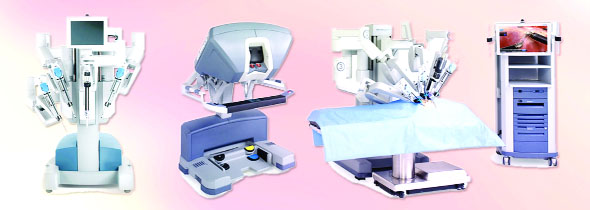Dr Rakesh Khera
The first documented use of a robot to assist with a surgical procedure occurred in 1985 when the PUMA 560 surgical arm was used in a neurosurgical biopsy. The first suggestion that prostatectomy could be done with the assistance of a robot came in 1989. The robotic system offered greater precision and a successful outcome and led to the first robot-assisted laparoscopic procedure in 1987. In 1990 the AESOP system produced by Computer Motion became the first system approved by the Food and Drug Administration (FDA) for its endoscopic surgical procedure.
In 2000, the da Vinci Surgery System broke new ground by becoming the first robotic surgery system approved by the FDA for general laparoscopic surgery. The 3 dimensional magnification “Endo-wrist” features of the operating arms precisely replicate the skilled movements of the surgeon at the controls, improving accuracy in small operating spaces. Today it is being used in increasing number of specialities including gynaecology, ENT, Cardiac Surgery, General Surgery, Orthopaedics and Urology.
In July 2006, India witnessed its first Robotic Assisted Surgery. Urologists were the forerunner in the use of Robotic technology and successfully performed first robot assisted radical prostatectomy. And since then, robotic surgery is always an exciting and an emerging frontier in the field of urology. Since then there are a substantial number of reports on performing complex urological procedures with robotic assistance with documented safety, efficacy and feasibility. It has a tremendous potential to progress in the future and it is important, that urologists should keep abreast of this newer technology, its limitations, and the possibility of incorporating it in day-to-day surgery. With the increased acceptance among the urologists in India robotics has started emerging in a big way.
Present Scenario:
In view of the potential advantages and latent qualities of robotic assistance in minimally invasive surgery over conventional surgery, robot-assisted surgeries have lead to a revolution of the way surgery is performed. Robot-assisted radical prostatectomy in the management of localized cancer of the prostate is one such example. A patient operated for robotic radical prostatectomy can be discharged on postoperative day 2 after removal of drain. In view of above advantages, more and more number of urologic procedures is being done with robotic assistance including uro-oncological procedures as adrenalectomy for adrenal gland tumours, partial and or radical nephrectomy for kidney cancers, radical or partial cystectomy and intracorporeal diversions for bladder cancer, retroperitoneal lymph node dissection for testicular tumours, videoendoscopic inguinal lymphadenectomy (VEIL) for penile tumours, urologic reconstructive procedures as pyeloplasty, ureteroureterostomy, urerteric reimplantation with Boari flap etc. Recently kidney transplantation is also being performed with robotic assistance with comparable outcomes especially in morbidly obese patients. It is also being increasingly used in urogynecologic as gynaeconcologic and pelvic floor reconstructive procedures as hysterectomy, myomectomy, ovarian cystectomy and sacrocolpopexy for vault prolapse with excellent oncologic and functional outcomes. All the above said procedures are being performed in India at dedicated centres increasingly with comparable outcomes. Also more and more literature is being published for our country with short and long term outcomes related to robotic surgery. Apart from Urology it is being increasingly applied to other surgical branches including surgical gasteroenterology, cardiothtoracic surgery, bariatric surgery, ENT and orthopaedics as well.
Future of Robotic Surgery:
The impact of robotics is very promising. Robotic technology is constantly emerging and future application may also allow integration of pre- and intraoperative imaging in the management of urological diseases. Advancements in making robotic surgery systems more capable of replicating the tactile feel and sensation a surgeon experiences during more invasive traditional procedures would give the surgeon the best of both worlds. The surgeon would gain the precision and advantages of minimally invasive procedures without losing the sensory information helpful in making judgment calls during robotic surgery and hence improve the outcomes.
The Challenges:
India today, is gaining momentum in the process of becoming a very competent Robotic Surgery destination. But most important concerns are the cost and training implications. The issues of cost of equipment and surgery are major hindrances to the widespread use of this technology in our country. It is difficult to expect a robotic revolution if the costs remain what they are today. However, expansion of indications with increased use, availability of better and cheaper robots worldwide, strengthening of health insurance covers, development of indigenous robots with comparable technology, institutionalisation of medical and surgical practices and increasing health care central budget may help in lowering of overall costs and better health care delivery. With Indians at the forefront of Robotics worldwide, it is not unreasonable to anticipate the development of an indigenous robotic surgical system in the future. The department of biomedical engineering at the Indian Institute of Technology have made some headway in the goal of developing our very own Indian prototype. Needless to say, such a system will go a long way in making this technology come within reach of a majority of our population.
Training implications is next big barrier in implementing the robotic technology in a right and big way. Structured training fellowship programs for Minimal invasive and Robotic Urology are at present available in only a few dedicated centres in India. Institutional availability of robots with digital simulators, inclusion of robotic training in urologic/surgical residency curriculum and a dedicated structured fellowship training programs will lead to better training of young budding urologists and hence improved overall outcomes at home.
(The author is a Director- Medanta Kidney & Urology Institute)
Trending Now
E-Paper


